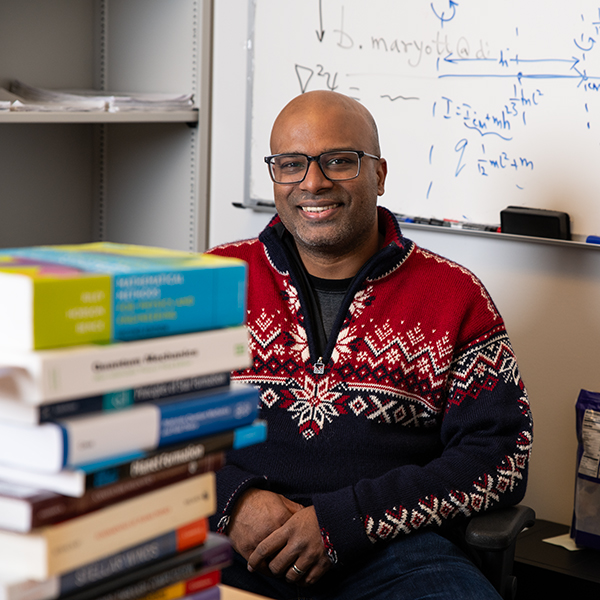There’s a pivotal moment in the 2023 Disney film Wish when the young protagonist Asha looks up into the night sky for comfort and guidance. As she casts her wish upon the brightest star in the heavens, her life transforms in a way she never could have imagined.
It’s a scene to which DigiPen professor Dr. Anand Thirumalai, who happens to be listed in the film’s credits, can probably relate. He too knows what it’s like to gaze upon the stars with curiosity and wonder. In a sense, he’s been doing it his entire life, tracing all the way back to his childhood upbringing in Delhi, India.
“Back then, New Delhi was very different. There wasn’t so much light pollution. You could actually sit out on your balcony, and you could see so many stars on a clear night. So even when I was about 4 or 5 years old, I remember talking to my dad, asking very simple questions: ‘What are all those things? Do we know what they are?’” Thirumalai recalls. “My dad said, ‘Well, maybe one day you’ll find out.’”
Decades later, Thirumalai’s cosmic curiosity remains as strong as ever. His level of knowledge, on the other hand, has advanced by some orders of magnitude. As an active astrophysicist and astronomer, he’s become one of the world’s leading experts on at least two advanced topics, both stemming from his Ph.D. research involving the evolution of stars. One topic is the strange behavior of atoms in highly magnetized environments, namely those found in the ultra-dense cores of collapsed massive stars, also called neutron stars.
“Neutron stars are the end product of stellar evolution of the most massive of stars,” Thirumalai says. “Betelgeuse is one such star, and when such stars go supernova, they will leave behind a tiny core of their erstwhile beings, if you will.”
Those tiny cores, he says, also happen to contain tiny atmospheres — about a quarter of an inch thick — wherein astrophysicists such as Thiurmalai can study the most powerful magnetic fields in the observable universe.
“I study the structure of atoms in such strong magnetic fields,” he says.
His other branch of expertise deals with white dwarfs, which are another type of stellar core, albeit one created not through a catastrophic supernova event, but rather through a gradual loss-of-mass process called stellar wind.

“Roughly 97% of the stars in the universe will end their lives as white dwarf stars, but we don’t quite understand how that mass-loss process occurs towards the very end of their lives,” Thirumalai says. “So I developed a mathematical model of stellar winds for a particular type of star called oxygen-rich asymptotic giant branch stars.”
If it all sounds a bit too complex or intimidating of a subject to comprehend, don’t be discouraged. If there’s anything Thirumalai loves as much as studying the cosmos, it’s sharing his passion and knowledge with others.
As such, in addition to his teaching and research endeavors, Thirumalai has also become a practiced public speaker, giving talks and lectures on general astronomy and astrophysics to audiences as near as Seattle and — as of last November — as far away as the University of Oslo in Norway. His invitation to the latter event came about thanks to his ongoing collaborations with a Norwegian research group working on projects related to quantum chemistry.
It was thanks to one such speaking engagement that Thirumalai was recently given the opportunity to contribute his knowledge towards something completely unexpected — the making of a Walt Disney Animation Studios film.
“I was invited to give a talk. I forget where. It’s been a couple of years now,” he says. “This was during the pandemic, so everything was online. There were people from all over the globe attending this talk, and I think one or two of them happened to be Disney people. They contacted me afterwards saying, ‘Hey, it was a nice talk. Would you like to talk to us about scientific consultation work?’ And I said, ‘Yeah, that sounds interesting.’”
That work concluded last December with the theatrical release of Wish — a film commemorating 100 years of Disney animation — for which Thirumalai received a “Special Thanks” credit.
“It was a very nice experience. A very lovely group of people,” he says.

With more and more popular entertainment venturing into the realm of science fiction and speculation — whether exploring parallel worlds and quantum entanglement in the Marvel cinematic universe or envisioning a future of interstellar colonization in series like The Expanse — Thirumalai is thrilled to see more people engaging with scientific ideas.
“I think what science fiction does at its core is it takes some science concept and then basically explores the human condition in one way or another,” he says. “It allows you to philosophize with a nugget of science in there — philosophize in a way that would be a bit restrictive if you were just thinking from a science perspective.”
Science-fiction entertainment can also serve as a kind of gateway, he says, instilling wonder in the minds of young people that can help put them on the path to discovering real-life opportunities in the scientific fields later in life. For similar reasons, Thirumalai says he also strives to communicate in a manner such that everyone can learn and benefit from what he has to share.
“I try to distill it down in a way I can explain to anyone — let’s say, a 5-year-old or a 10-year-old. How would I explain to them what these concepts are?” Thirumalai says. “I love doing that, and over the years, I think I’ve gotten better with experience on how to relate to a younger population, or people who may not have had that much exposure to science.”
Since joining the Department of Physics at DigiPen eight years ago, Thirumalai has taught everything from introductory physics courses to advanced independent studies in quantum mechanics. One of his higher-level courses, Advanced Mechanics, teaches students how to apply something called Lagrangian dynamics. As an alternative to Newtonian mechanics, it offers a more rigorous framework for measuring the movement and interaction of objects in the physical world, and it has a very useful application for video game developers: It’s a framework commonly used in physics simulation engines.
I thought, ‘Let me see if there’s a faculty position at DigiPen.’ And it so happened that DigiPen had indeed advertised for a faculty position in physics. So I just jumped on it.
In fact, it was no mere accident that brought Thirumalai to DigiPen in the first place. He first became interested in DigiPen during his post-doctoral studies at the University of Arizona after hearing about the college from a fellow student who worked on video games as a hobby.
“As I was finishing up my post-doc in 2015, I was looking for faculty positions across the globe, and then I thought, ‘You know, I think I like DigiPen.’ I thought it would be lovely to teach physics to a highly motivated set of students,” Thirumalai recalls. “I thought, ‘Let me see if there’s a faculty position at DigiPen.’ And it so happened that DigiPen had indeed advertised for a faculty position in physics. So I just jumped on it.”
Similar to his public speaking, Thirumalai is more than happy to tailor his teaching style and curriculum to the needs of his classroom audience, often providing examples of physics principles that are relevant to the challenges of game development.
“The way a physicist would simulate the physical world is all about accuracy, and in video games, one has to sacrifice a little bit of accuracy for computational overhead,” he explains. “At the same time, whatever you simulate on screen has to be believable. So it’s a delicate balancing act that a game programmer has to strike between believability and sacrificing accuracy.”
Regardless of whether his students go on to utilize physics knowledge in their day-to-day careers, Thirumalai continues to enjoy the opportunity to open students’ eyes toward a better understanding of the world around them.
“It’s very nice to see how when they first came here, they knew only a small nugget of information, and then it just expands and expands,” he says. “It’s an absolute joy.”
